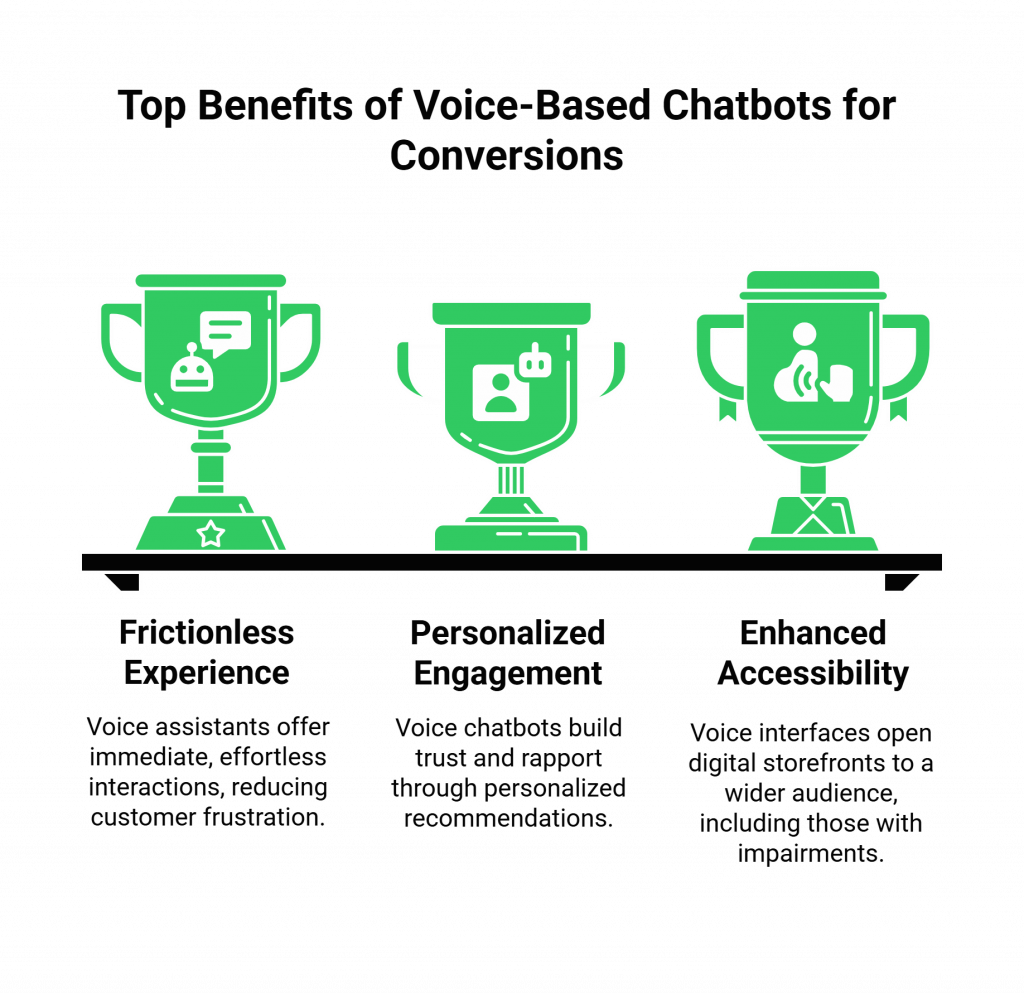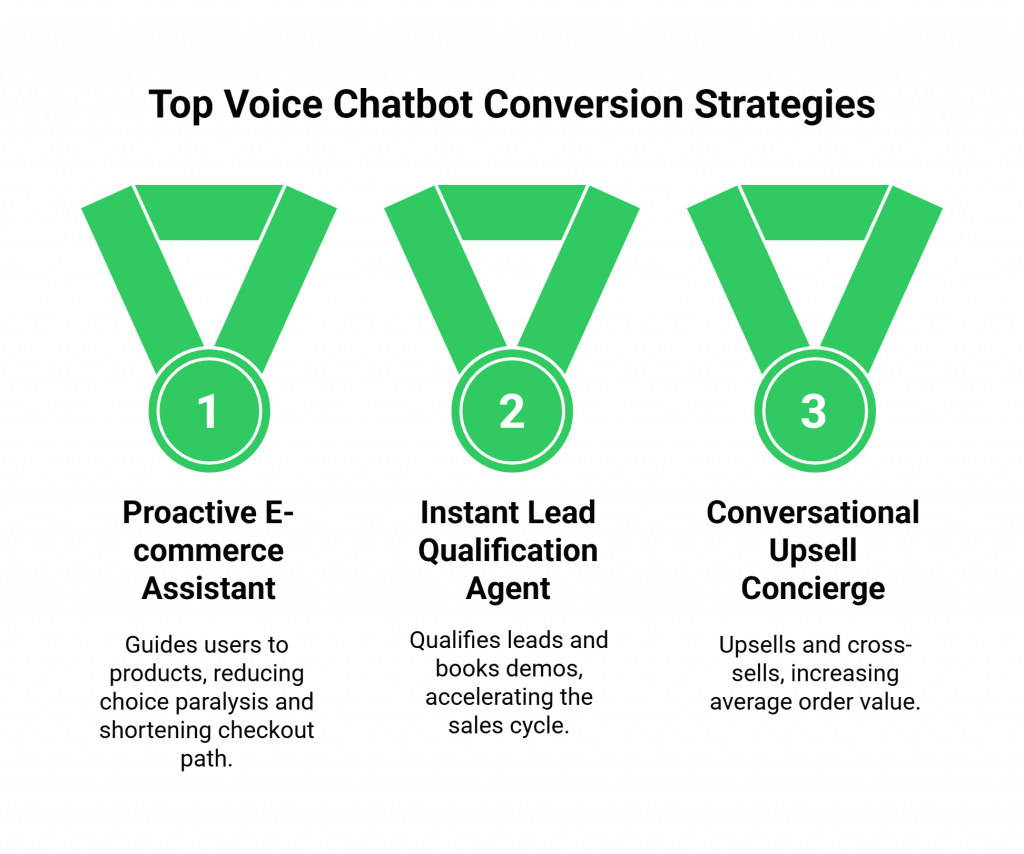We have all been there: endlessly scrolling through a website, trying to find a specific product or piece of information. You click through categories, apply filters, and open a dozen tabs, but the answer remains elusive. This digital fatigue is a silent killer of sales. When the path to purchase is filled with friction, potential customers simply give up and leave.
But what if your website could talk? What if, instead of forcing users to click, you could simply let them ask? This is the revolutionary power of a voice-based chatbot. It’s about moving beyond the limitations of text and creating a guided, conversational experience that feels less like navigating a website and more like talking to a helpful expert.
This is not just a futuristic feature; it’s a powerful conversion tool. This guide will move beyond the theory and showcase real-world voice chatbot example scenarios that are designed to do one thing: drive revenue. We’ll explore how a modern chatbot voice assistant can shorten the sales cycle, increase order value, and turn hesitant visitors into confident buyers.
Table of contents
Why Does a Voice-Based Chatbot Boost Conversions?
Before we dive into the examples, it’s crucial to understand why voice is such a powerful tool for conversion. The shift from a graphical user interface (GUI) to a voice user interface (VUI) addresses the core reasons why customers abandon a purchase.

How Does Voice Create a Frictionless Experience?
The number one enemy of conversion is friction. Voice is the ultimate friction-remover. It’s dramatically faster than typing; a user can speak their needs in a fraction of the time it would take to type them out on a mobile keyboard. This speed is what modern customers demand.
A HubSpot report found that 90% of customers rate an “immediate” response as important or very important when they have a customer service question, and a voice assistant is the most immediate interface of all.
How Can Voice Drive Engagement Through Personalization?
A voice feels more personal than text. A warm, friendly, and helpful chatbot voice assistant can build rapport and trust in a way that a silent chat window cannot. By connecting to your CRM, it can greet users by name and understand their purchase history, allowing it to make hyper-relevant, personalized recommendations.
This level of personalization is a massive driver of growth. A report from McKinsey found that companies that excel at personalization generate 40% more revenue from those activities than their slower-moving counterparts.
How Does Voice Make Your Business More Accessible?
A voice-based chatbot opens up your digital storefront to a wider audience. It provides a vital interface for users with visual or motor impairments and empowers the modern, multitasking user who might be browsing your site while their hands are busy.
Also Read: Voice Interface UX Mistakes Businesses Should Avoid
What Are Some Powerful Voice Chatbot Examples That Drive Sales?
Let’s move from the “why” to the “how.” Here are three powerful, real-world scenarios where a voice chatbot can have a direct and measurable impact on your conversion rates.

The Proactive E-commerce Shopping Assistant
The Scenario: A user lands on your e-commerce website. They have a specific need but are overwhelmed by the number of product categories and filters.
The Conversation: After a few seconds of browsing, a friendly voice assistant gently chimes in.
- AI: “Hi there! Looking for something special today? You can just tell me what you need, and I can help you find it.”
- User: “Yeah, I’m looking for a waterproof jacket for hiking, something in a dark color that’s not too expensive.”
- AI: “Great choice! I’ve just filtered our collection to show you our top-rated waterproof hiking jackets in black, navy, and charcoal, all under $150. Do you have any questions about the materials or features?”
The Conversion Impact: This voice chatbot example turns a frustrating search into a delightful, consultative experience. The AI acts as a personal shopper, instantly narrowing down the choices and overcoming the “paradox of choice.” This guided selling approach dramatically shortens the path to checkout.
To make this rapid-fire Q&A feel natural, the entire interaction must happen with ultra-low latency. This is where the voice infrastructure is critical. A platform like FreJun Teler is engineered for this kind of high-speed, real-time audio streaming, ensuring the conversation is always snappy and responsive.
Ready to turn your website visitors into buyers? Sign up for FreJun Teler & explore how voice infrastructure can power your conversion-focused chatbot.
The Instant Lead Qualification & Booking Agent
The Scenario: A potential B2B client is on the pricing page of your SaaS website, considering your different plans. This is a moment of high intent.
The Conversation: A chatbot voice assistant proactively offers help.
- AI: “Hi there! I see you’re looking at our pricing. Do you have any questions I can answer about the different tiers? I can also check if you qualify for a free, personalized demo.”
- User: “I’m curious about the Enterprise plan. What’s the main difference?”
- AI: “The Enterprise plan includes dedicated support and advanced security features. Based on your needs, a quick 15-minute demo might be the best way to see it in action. Are you the primary decision-maker for this kind of software?”
- User: “Yes, I am.”
- AI: “Perfect. I see our specialist, Sarah, has an opening tomorrow at 10 AM. Should I book that for you?”
The Conversion Impact: This is the ultimate “speed to lead” solution. The AI engages the prospect at their peak moment of interest, answers their initial questions, qualifies them based on your BANT criteria, and books a demo directly on your sales team’s calendar, all in a single, seamless conversation.
This closes the gap between interest and action, dramatically increasing the number of qualified meetings booked.
Also Read: How Multimodal AI Agents Transform Business Operations
The Conversational Upsell & Cross-Sell Concierge
The Scenario: A customer is in the process of booking a standard hotel room on your travel website.
The Conversation: Right before they click “confirm,” the voice based chatbot makes a helpful suggestion.
- AI: “You’ve selected a Standard King room. Excellent choice! Just so you know, for only $30 more per night, I can upgrade you to a room with a full ocean view. Would you be interested in that?”
- User: “Oh, that sounds nice. Yes, please.”
- AI: “Done. I’ve upgraded you to the Ocean View King. I also see you’re staying for the weekend. I can add our popular late checkout package for just $20. Should I add that to your reservation?”
The Conversion Impact: This voice chatbot example directly increases the Average Order Value (AOV). A conversational upsell is far more engaging and effective than a small, easily ignored pop-up banner. It feels like helpful, personalized advice from a concierge, not an aggressive sales tactic.
Conclusion
A voice-based chatbot is no longer just a futuristic novelty; it’s a proven and powerful tool for driving real business results. By creating a faster, more personal, and more engaging path to purchase, you can reduce friction, increase customer confidence, and directly boost your conversion rates.
These examples are just the beginning. By thinking of your chatbot voice assistant not as a simple Q&A machine, but as a proactive sales and service agent, you can unlock a new level of intelligent automation. The future of e-commerce and lead generation is conversational, and it’s time to give your business a voice.
Want to learn more about the infrastructure that powers the most effective voice chatbots? Schedule a demo with FreJun Teler today.
Also Read: Outbound Call Center Software: Essential Features, Benefits, and Top Providers
Frequently Asked Questions (FAQs)
A voice-based chatbot, or voice assistant, is a conversational AI that users interact with by speaking. It uses Speech-to-Text (STT) to understand the user’s spoken words and Text-to-Speech (TTS) to provide a spoken response, creating a hands-free, conversational experience.
The core “brain” or logic can be the same. The main difference is the interface. A text chatbot uses a keyboard and a chat window, while a voice chatbot uses a microphone and a speaker, which is a much faster and more natural way for humans to communicate.
No. A website-based voice chatbot operates over the internet using WebRTC technology. It does not require a traditional phone number to function.
It increases conversions by reducing friction in the buying process. It allows users to find what they need faster, get their questions answered instantly, and receive personalized, guided assistance, all of which builds confidence and shortens the path to purchase.
When designed correctly, it’s helpful, not annoying. The key is to be non-intrusive. The bot should only offer to help after a user has been on a page for a few seconds or shows signs of confusion. The user always has the choice to engage or to ignore it.
You measure its success with clear business metrics, such as the increase in sales that were assisted by the bot, the rise in Average Order Value (AOV) from successful upsells, or the increase in the number of qualified sales demos booked through the bot.
Yes. The ability to understand accents is a feature of the Speech-to-Text (STT) model you choose to integrate with. The best strategy is to select a world-class STT model from a major provider that has trained its AI on a massive, diverse global dataset.
A model-agnostic platform like FreJun Teler is not tied to a specific AI “brain.” It gives you the freedom to use your own existing chatbot logic or to choose the best LLM on the market for your specific sales and conversion goals.
Yes, and this is the best approach. Offering users the choice of how they want to interact (typing or speaking) provides the most flexible and inclusive user experience.
FreJun Teler provides the essential voice infrastructure, or the “nervous system.” Its Web SDK makes it easy to add the microphone button to your website, and its global network handles the high-speed, low-latency streaming of audio between the user and your AI, ensuring the conversation is always crystal-clear and responsive.
